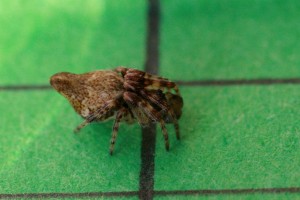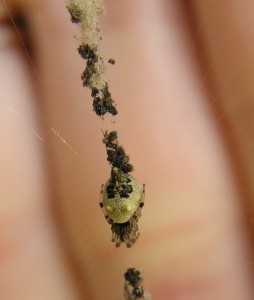The little hoarder
Not even the wussiest spider hater should hate wee Cyclosa. This one is twice hidden from fearful eyes: first, because she’s nothing but a crumb in the garden, smaller than small (6mm). Second, because she puts herself in an unobtrusive web that she’s filled with junk, and hides therein. She’s a disguise spider and an artist who works with found materials. Humble, too: no impersonating of hornets or ants, no lurking inside a tunnel and then thundering out, nothing vivid or glossy. If she’s around, the only clue might be a grimy bit of silk connecting a plant and its pot. The miniature hunter hides there, in all her trashy glory, awaiting even tinier prey.
I cross paths with Cyclosa rarely, usually when she’s set up shop below the leaves of a container plant I’ve placed at eye level. Walking by, I glance at the shrub to see how it’s doing, and notice this six-inch line that looks like a strand of Christmas-tree tinsel, if you decorated with burrito wrappers and empty water bottles and apple cores. Upon closer inspection it reveals itself to be a dun-colored spider, her abdomen a tiny seashell, her legs all bunched around her face as if caught mid-peekaboo, waiting among a collection of dead bugs and other debris. For a long time I thought this web was just lint or dog hair or some other kind of yard snot.
Haven’t looked closely enough to see whether she’s Cyclosa conica, a cosmopolitan species well established in the Northern Hemisphere, or Cyclosa turbinata, also seen in this part of the Bay Area. It takes a very practiced eye to tell them apart, a familiar problem in spider-watching. Conica and turbinata are both pretty much the same name, ’scuse my weak Latin: cone-shaped. In lurk mode therefore they look like miniature hermit crabs.
Cyclosas are pocket-sized members of the orb weaver family, the esteemed clan that includes those graceful, gumdrop-shaped beauties with the huge, circular nighttime webs no one likes to walk into. Cyclosa means the turning spider, a name she somehow copped from her more magnificent relatives and hoarded to herself. Such are naming conventions. But the works of Cyclosa do have the same sophistication, writ small, as those of her big relations. Her little clothesline of dirty laundry is part of a larger, less obvious wheel, built from multiple types of silk that catch insect prey and signal the spider to come running. Like all web-building spiders she sits and listens with her body to the vibrations that come her way, pivoting toward movement, plucking lines to see if it’s something worth charging out of concealment for, attacking and subduing and swaddling the prey if so.
Humans try to plumb the reasoning of little animals that aren’t even aware of themselves. The motives of Cyclosa and other relatives that decorate their webs with objects, zigzag silken lines, even what appear to be writing (“SOME PIG”) are surprisingly hard to pin down. Spider researchers argue about this. What combination of attraction and repulsion do the decorations perform? Ponder the fact that at least one kind of Cyclosa, this one observed on an island off the coast of Taiwan, builds exact decoys of itself and its egg sacs. It attracts more predators than the standard-issue Cyclosa, yes, but it also fools them more reliably. Come and get me! taunts the clever hoarder. Yet she comes out ahead.

"Trash line spider"? I beg to differ. It's called recycling. (Rhithrogena22 photo; licensed under Creative Commons)
In true evolutionary fashion Cyclosa doesn’t need to know that the cluttered front yard where she leaves the dead husks is protecting her from birds, wasps, or annoyances like me. Her ancestors just had to have behaved as she does. And they passed on their genes for surviving amid a tiny pile of trash.
